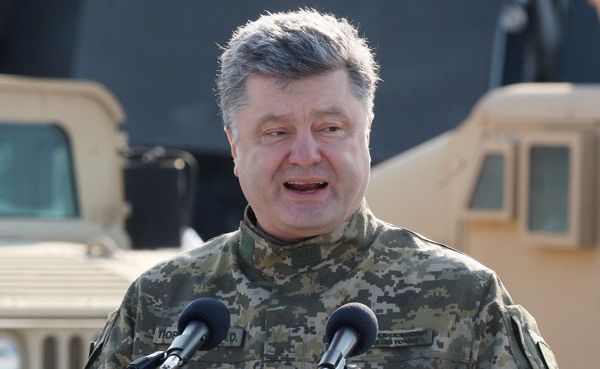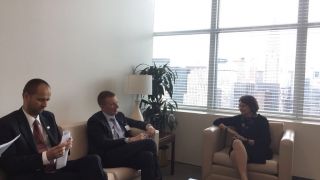The best explanation of why Ukrainian President Petro Poroshenko is going to organize a referendum on Ukraine’s accession into NATO is that he wants to have this “hot-button topic” just in case he faces mid-term elections. Time will show if that will be parliamentary or presidential elections.
Legislative dispositions
Contrary to the generally accepted myth, Ukraine’s Constitution does not say anything about its non-bloc or neutral status. The only document mentioning neutrality is the declaration of state sovereignty adopted in 1990. Its article IX says, “The Ukrainian SSR solemnly declares its intention of becoming a permanently neutral state that does not participate in military blocs and adheres to three nuclear free principles: to accept, to produce and to purchase no nuclear weapons.”
There were two more documents mentioning Ukraine’s non-bloc status – Ukraine’s former military doctrine and the previous version of the law on the principles of domestic and foreign policies – but Poroshenko and his parliamentary majority have annulled both.
Technology of “managed referendum”
If Poroshenko is serious, he will need a legislative basis. The existing law on all-Ukrainian referendum was approved by Viktor Yanukovych’s Supreme Rada (on Nov 6, 2012) and it gives the president very broad powers:
- the president has the authority to organize an all-Ukrainian referendum on the basis of a national initiative – on the insistence of no less than three million Ukrainians. But the contradiction is that the constitution gives the same authority to the Supreme Rada;
- it is exactly for the president and the Central Electoral Commission to decide if the question and the text put up for the referendum comply with Ukraine’s constitution and laws (the previous version stipulated this duty for the Constitutional Court);
- but the main thing here is that the vote counting is controlled by the presidential system – unless the heads of the Supreme Council of Crimea and regional councils, the mayor of Kiev and the head of the city council of Sevastopol apply for seats in the referendum commissions, the commissions will consist of he heads of the state administrations of Kiev, Sevastopol, the governors and the heads of district administrations – that is, officials appointed by the presidential administration.
There is a popular term “managed democracy.” In Ukraine’s case, we may say that Poroshenko’s men are going to use the technology of “managed referendum.”
Old yeast
Poroshenko’s last German interview is not the first example of him mentioning NATO referendum. He first mentioned it in late 2014 during Lithuanian President Dalia Grybauskaite’s visit to Kiev.
For this purpose, Poroshenko may adopt a new law on referendum or use the existing one but in any case, it is not for him to decide. The one who decides here is NATO. For Ukraine to have a chance to join NATO, it needs the votes of all 28 NATO ministers. Afterwards, it will have two alternatives:
- Individual Partnership Action Plan. NATO already had such a plan for Ukraine in 2002-2010. During that period, the sides had a special inter-department commission and a NATO information center and conducted joint exercises.
- Membership Action Plan. The example of FYR Macedonia, who was given such a plan in 1999 but is still outside NATO, has shown that this process may last for quite a long time.
The last time Ukraine had a chance to get MAP was July 2016, when NATO organized a presidential summit in Warsaw. But even though Poroshenko was there, none of NATO leaders mentioned any MAP for Ukraine.
As you can see, Ukraine has neither IPAP nor MAP. So, even if 99% of the Ukrainians vote for NATO membership, Ukraine will not be able to join the alliance.
“Parallel referendum”
But if the referendum has no practical sense, this means that Poroshenko has another goal in mind. In the early 2000s, this gimmick was used by the Ukrainian Socialists led by Oleksandr Moroz.
That was just a wish. Today Poroshenko has more chances to use this mechanism as he enjoys certain legal advantages.
And the key factor is the continuing war in Donbass. The war is scaring and infuriating the people. The referendum may help Poroshenko to harness these emotions. His answer to those scared will be “NATO will protect you.” So, the worse the situation in Donbass, the better the president’s chances for organizing the referendum.
Thus, if we are dealing with a political technology, there are two scenarios:
Scenario 1 – to improve President Poroshenko’s rating. In his German interview, Poroshenko mentioned the results of polls, where 54% of the Ukrainians expressed support for NATO. That is, by organizing the referendum, Poroshenko’s men may try:
- a) to show that Poroshenko supports the initiative allegedly supported by most of the Ukrainians;
- b) to convince the voters that Poroshenko is their mouthpiece.
Scenario 2 – parallel referendum. The point is to conduct the referendum at one and the same time with some elections. The goals are to improve the turnout and to canvass for Poroshenko as a politician whose pro-NATO position coincides with the wishes of most of the voters.
In both cases, we are dealing with a political technology but the second scenario seems to be more possible.
Sergey Slobodchuk, political advisor (Kiev, Ukraine), specially for EADaily

 Miscalculated: Zelensky curtailed a visit to South Africa
Miscalculated: Zelensky curtailed a visit to South Africa A new group strike on Kiev has been launched — the most destructive since the beginning of SMO
A new group strike on Kiev has been launched — the most destructive since the beginning of SMO Migrants from Central Asia preparing an explosion at a refinery in the Nizhny Novgorod region were destroyed
Migrants from Central Asia preparing an explosion at a refinery in the Nizhny Novgorod region were destroyed Musk and the US Treasury Secretary staged a public scandal in the presence of Trump
Musk and the US Treasury Secretary staged a public scandal in the presence of Trump Negotiations in London are disrupted: Zelensky started the game of pan or disappeared — MP
Negotiations in London are disrupted: Zelensky started the game of pan or disappeared — MP Macron's offices and Starmer was shot on the topic of the Ukrainian conflict
Macron's offices and Starmer was shot on the topic of the Ukrainian conflict